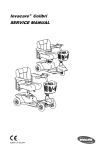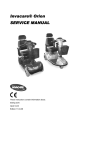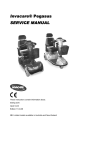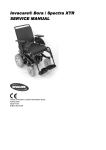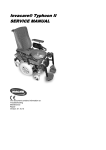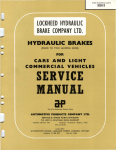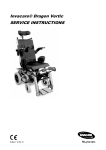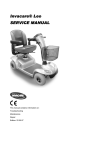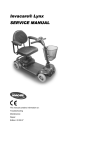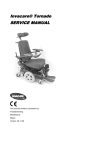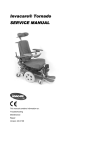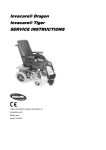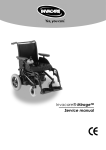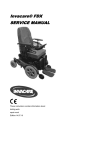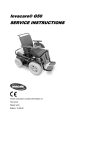Download Invacare® Typhoon II SERVICE MANUAL
Transcript
Invacare® Typhoon II SERVICE MANUAL This document contains information on: Troubleshooting Maintenance Repair Version: 08.02.08 2 Mobitec Mobilitätshilfen GmbH Herzog Odilostrasse 101 A-5310 Mondsee Austria Fax: @: @: WWW: +43 - 6232 - 55 35 0 +43 - 6232 - 55 35 4 [email protected] [email protected] www.mobitec-austria.com Invacare® n.v. Autobaan 22 B-8210 Loppem (Brugge) Belgium Fax: @: WWW: +32 - (0)50 - 83 10 10 +32 - (0)50 - 83 10 11 [email protected] www.invacare.be Mobitec Rehab AG Benkenstraße 260 CH-4108 Witterswil Switzerland Fax: @: @: WWW: +41 - (0)61 - 48 77 08 0 +41 - (0)61 - 48 77 08 1 [email protected] [email protected] www.mobitec-rehab.ch Invacare Aquatec Alemannenstraße 10 88316 Isny Deutschland Fax @: WWW: 0 75 62 / 7 00 - 251 08 00 / 6 73 81 72 [email protected] www.invacare-aquatec.de Invacare® A/S Sdr. Ringvej 39 DK-2605 Brøndby Danmark (Kundeservice): Fax (Kundeservice): @: WWW: Invacare® SA c/ Areny, s/n Poligon Industrial de Celrà 17460 Celrà (Girona) ESPAÑA : Fax: @: WWW: +34 - (0)972 - 49 32 00 +34 - (0)972 - 49 32 20 [email protected] www.invacare.es Invacare® Poirier SAS Route de St Roch F-37230 Fondettes France : Fax : @: WWW: +33 - (0)247 - 62 64 66 +33 - (0)247 - 42 12 24 [email protected] www.invacare.fr Invacare® Ltd South Road Bridgend Industrial Estate Mid Glamorgan - CF31-3PY United Kingdom (Customer Service): +44 - (0)1656 - 664 321 Fax (Customer Service): +44 - (0)1656 - 667 532 @: [email protected] @: [email protected] WWW: www.invacare.co.uk Invacare Mecc San s.r.l. Via Dei Pini, 62 I - 36016 Thiene (VI) ITALIA Fax: @: WWW: Invacare Ireland Ltd. Unit 5 Seatown Business Campus Seatown Rd, Swords County Dublin Ireland Fax: @: Invacare® AS Grensesvingen 9 Postboks 6230 N-0603 Oslo Norge (Kundeservice): Fax (Kundeservice): @: WWW: +47 - (0)22 57 95 10 +47 - (0)22 57 95 01 [email protected] www.invacare.no Invacare® B.V. Celsiusstraat 46 NL-6716 BZ Ede The Netherlands : Fax: @: WWW: +31 - (0)318 - 69 57 57 +31 - (0)318 - 69 57 58 [email protected] www.invacare.nl +45 - (0)36 - 90 00 00 +45 - (0)36 - 90 00 01 [email protected] www.invacare.dk +39 - 0445 - 38 00 59 +39 - 0445 - 38 00 34 [email protected] www.invacare.it +353 - 18 10 70 84 +353 - 18 10 70 85 [email protected] Invacare® PORTUGAL Lda Rua Senhora de Campanhã 105 P-4369-001 Porto PORTUGAL : Fax: @: WWW: +351-225105946 +351-225105739 [email protected] www.invacare.pt Återförsäljare: Invacare® AB Fagerstagatan 9 S-163 91 Spånga Sverige (Kundtjänst): Fax (Kundtjänst): @: @: WWW: +46 - (0) 8 761 70 90 +46 - (0) 8 761 81 08 [email protected] [email protected] www.invacare.se Tillverkare: Invacare® Deutschland GmbH Kleiststraße 49 D-32457 Porta Westfalica Deutschland MÖLNDAL Fax: @: +46 - (0) 31 – 86 36 00 +46 - (0) 31 – 86 36 06 [email protected] LANDSKRONA Fax: @: +46 - (0) 418 – 285 40 +46 - (0) 418 – 180 89 [email protected] OSKARSHAMN Fax: @: +46 - (0) 491 – 101 40 +46 - (0) 491 – 101 80 [email protected] 3 Table of Contents Chapter Page 1 INTRODUCTION 6 1.1 General information 6 1.2 Notes on transport 6 1.3 Important symbols in this manual 6 2 SAFETY AND ASSEMBLY INSTRUCTIONS 8 2.1 Before any inspection or repair work 8 2.2 General safety information and notes on assembly / disassembly 8 3 TIGHTENING TORQUES 9 4 LAYOUT OF MODULES, COMPONENTS AND DISPLAYS AND CONTROLS 10 5 SERVICE PLAN (1X ANNUALLY) 11 6 OPERATIONAL FAULTS 13 6.1 Operational faults on electric wheelchair with ACS 6.1.1 Drive fault diagnosis 6.1.2 Fault diagnosis with electric actuator motors 6.1.3 REM24 Error Codes and Diagnostic Codes 13 13 15 16 7 18 REPAIR WORK 7.1 Replacing and calibrating drive motor 7.1.1 Replacing the motor 7.1.1.1 Removing wheel rim and tyres on vehicle with pneumatic tyres 7.1.1.2 Removing wheel rim and tyres on vehicle with puncture-proof tyres 7.1.1.3 Continuing dismounting the motor 7.1.1.4 Reassembling wheel rim and tyres on vehicle with pneumatic tyres 7.1.1.5 Reassembling wheel rim and tyres on vehicle with puncture-proof tyres 7.1.2 Calibration of GB motors 18 18 20 21 21 23 23 26 7.2 Replacing electronic components 28 7.3 Replacing batteries 30 7.4 Replacing the main fuse. 36 7.5 Checking the cables 38 4 7.6 Replacing the ACS Remote 39 7.7 Updating the software 41 7.8 Checking an actuator motor 42 7.9 Adjusting and replacing the speed reduction switch 43 7.10 Replacing the steering head bearings on the front and rear steering wheels 7.10.1 Front steering wheels 7.10.2 Rear steering wheels and 44 44 45 5 1 Introduction 1.1 General information 1.2 1.3 • All maintenance and overhaul work must be carried out in accordance with these repair instructions. • Please observe all safety instructions. • Information about operation or about general maintenance and care work should be taken from the electric vehicle Operating Manual. • You can find information about ordering spare parts in the spare parts catalogue. • Use only genuine Invacare® spare parts. Using parts from any other source will void the warranty! • We reserve the right to make any alterations on the grounds of technical improvements. • The electric vehicle may only be maintained and overhauled by qualified personnel. • The minimum requirement for service technicians is relevant training, such as in the cycle or orthopaedic mechanics fields, or suitably long-term job experience. - Experience and knowledge of electrical measuring devices (Multimeter) is also a requirement. - Special Invacare training sessions are recommended. • Alterations to the electric vehicle which occur as a result of incorrectly or improperly executed maintenance or overhaul work lead to the exclusion of all liability on the part of INVACARE. • If you have any problems or questions please contact INVACARE SERVICE. Notes on transport • If the electric vehicle has to be shipped back to the manufacturer for major repairs, you should always use the original packaging for transport. • You should also include as accurate a fault description as possible. Important symbols in this manual WARNING! This symbol warns you of danger! • Always follow the instructions to avoid injury to the user or damage to the product! EXPLOSION HAZARD! This symbol warns you of an explosion hazard, an example of which can be caused by excessive tyre pressure in a pneumatic tyre! • Always follow the instructions to avoid injury to the user or damage to the product! BURN HAZARD! This symbol warns you of burns due, for example, to leaking battery acid! • Always follow the instructions to avoid injury to the user or damage to the product! NOTE: This symbol identifies general information which is intended to simplify working with your product and which refers to special functions. Requirements: • This symbol identifies a list of various tools, components and items which you will need in order to carry out certain work. 6 7 2 Safety and assembly instructions These safety instructions are intended to prevent accidents during work and it is imperative that they are observed. 2.1 2.2 Before any inspection or repair work • Read and observe this repair manual and the associated operating manual! • Observe the minimum requirements for carrying out the work (see chapter entitled "General information”)! General safety information and notes on assembly / disassembly Danger of injury by crushing! • Please note the heavy weight of some components. This applies especially to removal of drive units and batteries! • Prop up the lifted electric vehicle with appropriate supports before starting the disassembly or assembly! Danger of fire and burns due to electrical short-circuit! • The electric vehicle must be switched off before removal of voltage-carrying components! To do this, disconnect the batteries! • When making measurements on voltage-carrying components, avoid short-circuiting the contacts. Danger of fire and combustion! Danger of injury and damage to the vehicle can result from incorrect or incomplete maintenance! • Only ever use tools which are undamaged in good condition! • Some moving parts have Teflon bushings! These parts must never be lubricated with grease! • Never use standard nuts instead of self-locking nuts! • Always use correctly dimensioned washers or spacers! • Cable binders which have been cut off during disassembly should be replaced with new ones during reassembly! • After completing maintenance work and before operating the electric vehicle, make sure all fixations are correctly secured! Check all parts for correct interlocking1 • Only operate the electric vehicle with correct tyre pressure (see Technical Specifications)! • Check electrical components for correct functioning, incorrect polarity of cables can result in damage to the electronics! • As a last check, always carry out a test-drive! Notes Mark all current settings for the electric vehicle (seat, armrests, backrest etc.), and the cable connecting plugs associated, before any removals. This makes reassembly easier. All plugs are fitted with mechanical safety devices which prevent release of the connecting plugs during operation. To release the connecting plugs the safety devices must be pressed in. When reassembling, ensure that these safety devices are correctly engaged. WARNING: Any alteration to the drive programme can influence vehicle handling and the tipping stability of the electric vehicle! • Alterations to the drive programme may only be carried out by trained Invacare® dealers! • Invacare® supplies all electric vehicles from the factory with a standard drive programme. Invacare® can only assume a warranty for the safe vehicle handling of the electric vehicle – in particular tipping stability - for this standard drive programme! 8 3 Tightening torques The tightening torques stated in the following table are dependent on the thread diameters for the nuts and bolts for which no special values are determined. All values apply to dry and grease-free threads. Thread Tightening torque in Nm ±10% M4 3 Nm M5 6 Nm M6 10 Nm M8 25 Nm M10 49 Nm M12 80 Nm M14 M16 120 Nm 180 Nm Caution: All other nuts or plastic connectors not noted here must be tightened FINGERTIGHT! 9 4 Layout of modules, components and displays and controls The following figure shows the Typhoon II from behind with extended seat lifter and the rear panelling removed. 1 2 3 4 5 Seat lean adjustment Seat frames / rear panelling anti-collision switch Speed controller Main module (power module) Lighting/actuator module The following figure shows the Typhoon II from front right with raised lifter. 1 10 Lifter servo motor 5 Service plan (1x annually) Component Armrests and side panels Seat unit / adjustable seat inclination Mechanical backrest Electrical backrest Frame (chassis) / battery mounting Wheel suspension and wheels Drive units, clutch mechanism Check Remedy • Armrest damage and fastening Side panel damage and fixing Top surface Check adjustable seat inclination ⇒ Tighten screws, replace top surface if damaged ⇒ Tighten screws, replace side panels if damaged ⇒ Replace cover / upholstery if damaged. ⇒ Replace parts if damaged. Damage and seams Fixing Check cable Check function Check fixings, welded seams and battery mounting Check drive wheels for tight fit and side play ⇒ Replace parts if damaged. ⇒ Tighten screws ⇒ Replace cable or motor if necessary • Check steering wheels for tight fit, float and side play ⇒ Replace wheels, wheel fork or wheel bearings • Check drive wheel pneumatic tyres Check functions in drive and push modes Check clutch mechanism Check welded seams, interlocking, screws, footplates Check cable Check contacts check functions Check cable Check function Check batteries for damage Check battery voltage Check contacts and terminals ⇒ Repair or replace if damaged ⇒ Replace motor if necessary ⇒ Tighten screws / nuts, adjust or replace if necessary ⇒ Tighten, remove if necessary • • • • • • • • • • • Legrests Electrical legrests Lighting Batteries • • • • • • • • • Note 9 ⇒ Tighten screws, replace components ⇒ Adjust, replace wheel hubs See "Replacing and calibrating drive motor" on page 18 See "Replacing the steering head bearings on the front and rear steering wheels" on page 44 see operating manual ⇒ Replace cable if necessary ⇒ Replace bulbs or cable if necessary ⇒ Replace batteries if necessary ⇒ charge batteries ⇒ Clean contacts and terminals See "Replacing " on page 30 See operating manual See "Replacing " on page 30 for safety information on handling batteries 11 Component Remote / drive electronics Lifter module Check Remedy • ⇒ ⇒ ⇒ ⇒ ⇒ • • • • • • Drive program 12 • Remote, status display blinking Fixing Cable, connecting plug Joystick function Power supply Check for correct functioning Check locking device function. Check drive electronics program version Newer version available? Note Evaluate blinking code Tighten, replace Replace Replace joystick Replace cable, connecting plug or console ⇒ Repair if necessary. • Update software See "Updating the software" on page 41 9 6 Operational faults 6.1 Operational faults on electric wheelchair with ACS If you have problems with the wheelchair, please proceed as follows: • First assess the possible cause of the problem using the following table. • Check the status display on the remote. Evaluate the blink error code. • Carry out the necessary checks and repairs as recommended in the following table. NOTE: You can find more information about operational faults on electric wheelchairs with GB motors in the document entitled “Dynamic DX-GB-AS Power Module - Assembly Instructions”, order no. 1441533 6.1.1 Drive fault diagnosis PROBLEM Wheelchair will not start OTHER SYMPTOMS Remote status display illuminates normally without showing an error code Remote status display does not illuminate POSSIBLE CAUSE Drive motors possibly disengaged SOLUTION Documentation • Re-engage drive motors See operating manual Batteries possibly defective • Replace batteries See "Replacing " on page 30 Batteries possibly overdischarged Power supply to remote possibly interrupted • Pre-charge batteries See operating manual • Check master fuse See "Replacing the main fuse" on page 36 • Check cable between modules for loose connections or damage • Replace the remote on the wheelchair in order to rule out the possibility that the remote is causing the fault. • Assess error code See "Checking the cables" on page 38 Remote possibly defective Remote status display blinking Various causes See "Replacing the ACS Remote" on page 39 See "REM24 Error Codes and Diagnostic Codes" on page 16 13 PROBLEM Wheelchair judders in drive mode Batteries not being charged Wheelchair runs too slowly OTHER SYMPTOMS Status display on remote blinking 2x, drive display on "U" None None LEDs blinking on charging unit Status display on remote blinking 2x, drive display on "U" None 14 POSSIBLE CAUSE Speed controller on lifter possibly defective or not connected Batteries possibly defective (voltage unstable) Drive motor(s) possibly defective Batteries possibly defective Charging device possibly defective Seat lifter is not in drive position (either too high or too low) and has activated automatic speed regulation. Speed controller on seat lifter may be badly adjusted. Remote possibly defective Batteries possibly defective SOLUTION Documentation • Replace cable or switch See "Adjusting and replacing the speed reduction switch" on page 43 • Replace batteries See "Replacing " on page 30 • Replace motor(s) • Replace batteries See "Replacing and calibrating drive motor" on pages 18 and "Replacing and calibrating drive motor" on page 18 See "Replacing " on page 30 • Replace charging unit See charging unit operating manual • Run the seat lifter to the drive position See operating manual • Adjust regulator See "Adjusting and replacing the speed reduction switch" on page 43 • Replace remote See "Replacing the ACS Remote" on page 39 See "Replacing " on page 30 • Replace batteries 6.1.2 Fault diagnosis with electric actuator motors Please use the following table to assess fault causes when using electric actuator motors. PROBLEM Electric actuator motor does not react OTHER SYMPTOMS Remote shows blinking "E", status diode on lighting/actuator module does not go out even if the remote is switched off or disconnected. None POSSIBLE CAUSE Lighting / actuator module defective Cable possibly disconnected or damaged Electrical actuator motor possibly defective Remote possibly defective SOLUTION Documentation • Replace lighting/actuator module See "Replacing electronic components" on page 28 • Check to ensure that the cable has not been disconnected or damaged. Replace cable if necessary • Test actuator motor See "Checking the cables" on page 38 • Replace the remote on the wheelchair in order to rule out the possibility that the remote is causing the fault. See "Replacing the ACS Remote" on page 39 See "Checking an actuator motor" on page 42 15 6.1.3 REM24 Error Codes and Diagnostic Codes The drive electronics are capable of rectifying some errors automatically. In this case the status display will cease to flash. Please switch the remote on and off several times. Wait approx. 5 seconds each time before switching the remote on again. If this does not rectify the error, locate the error using the flash codes shown below. Flash code: 1 x flash Meaning: Module defective 2 x flashes Accessory error (e.g. actuator short-circuit) Solution: Notes • Replace defective module See "Replacing electronic components" on page 28 See "Checking an • Check accessory actuator motor" on page connections, check 42 accessories Lifter raised or • lowered too far (seat not at driving height) 3 x flashes 4 x flashes 5 x flashes 6 x flashes 7 x flashes 8 x flashes Connection on the left motor loose/defective Left motor defective. • • Check/replace motor Connection on the right motor loose/defective Right motor defective. • Check plug-in connections. • Check/replace motor Fault/brake fault on left-hand motor. Connection loose/defective or motor defective. Left motor disengaged (GBmotors) Both motors disengaged (standard motors) Fault/brake fault on right-hand motor. Connection loose/defective or motor defective. Right motor disengaged (GBmotors) Battery dead Battery voltage too high • Check plug-in connections. • Engage motor. Shut electronics down and then switch on again. Engage motors. Shut electronics down and then switch on again. Check plug-in connections. See User Manual Engage motor. Shut electronics down and then switch on again. Pre-charge battery Switch lights on to lower battery voltage Check battery charger See User Manual • • • • • • 16 See User Manual If lifter is raised, lower in stages until the status display stops flashing. If lowered too far, raise lifter in stages until the status display stops flashing. If at all possible, only drive when the seat is at driving height. See "Checking the Check plug-in cables" on page 38 connections. See "Replacing and calibrating drive motor" on page 18 See "Checking the cables" on page 38 See "Replacing and calibrating drive motor" on page 18 See "Checking the cables" on page 38 See User Manual See "Checking the cables" on page 38 See User Manual See User Manual of battery charger Flash code: 9 or 10 x flashes Meaning: Faulty data transmission between modules 11 x flashes Motors overloaded • / overheated Module used has • compatibility problems 12 x flashes Solution: • - Notes Remove all electronic modules except the Power Module and the Remote. Re-attach modules one by one to determine which one is causing the fault. See "Replacing electronic components" on page 28 Switch remote on and off / wait if necessary Remove incorrect module See "Replacing electronic components" on page 28 17 7 Repair Work CAUTION: Risk of damage to the vehicle! Collisions can be caused if shim rings are removed from the drive wheels during installation work! • Shim rings are frequently placed between the drive shaft and the wheel hub to compensate tolerances. Collisions can be caused if these shim rings are removed and not re-installed! Please install all shim rings in exactly the same positions they were in before dismantling. 7.1 Replacing and calibrating drive motor The following two sections describe how a GB motor is replaced and a new motor is calibrated. We recommend that you read these instructions completely through before commencing work. GUIDELINE – First find out whether the vehicle is fitted with puncture-proof tyres or pneumatic tyres! The course of action during disassembly is different depending on whether the vehicle is fitted with puncture-proof tyres or standard pneumatic tyres ! You can recognise puncture-proof tyres by the fact that they do not have a valve ! 7.1.1 Replacing the motor CAUTION! Danger because wheelchair can tip or roll away ! • Prevent the wheelchair from tipping by inserting a wooden block which is long and wide enough under the battery case! If the wooden block is too short or too narrow the wheelchair can still tip! • Switch the wheelchair off at the remote! EXPLOSION HAZARD! If the wheelchair is fitted with pneumatic tyres, the wheel can explode if the air is not released from the tyre before removing the wheel ! • Always release the air from the wheel before it is removed (depress the small tappet in the centre of the valve) ! CAUTION! If the wheelchair is fitted with puncture-proof tyres, the liquid in the tyres can block the valve when air is released if the valve is at the bottom ! The air cannot then be released! • Before releasing air from the wheel, always turn the wheel so that the valve is at the top ! Injury hazard! The wheelchair will drive in an uncontrolled manner if the GB motors are not calibrated after being fitted new ! • Ensure that the GB motors have been calibrated after being fitted! 18 Injury hazard! If the bolts which secure the wheel are not tightened firmly enough, or if the threaded holes in the casing are damaged by being tightened too much, the wheel can come loose during travel ! • Always position the nuts manually in their holes when fitting the drive wheels. • Never use electrical or pneumatic screwdrivers ! • Tighten the Allen screws with a torque of 25 Nm ! • The Nordlock washers must be fitted exactly as they were before removal ! NOTES REGARDING GB MOTOR GUARANTEE: If motors become defective within their guarantee period, they will either be replaced or repaired on Invacare's decision. This guarantee does not cover pay for working hours. We also accept no liability for physical injuries or unauthorised repairs. Invacare's sole obligation and its exclusive remedy during this guarantee is limited to such repair and/or replacement measures. Required parts/tools: • wooden block to support vehicle • Allen key 4 mm • Allen key 5 mm • Allen key 6m • Allen key 10 mm • circIip pliers • jaw spanner 10 mm • Torque wrench Additional parts/tools for fitting puncture-proof tyres • tyre fitting paste (soap-based) • 3 bolts M8 x 30mm (for provisional positioning of wheel rim during fitting) NOTE: Take note of small parts and the sequence in which components have been fitted. Arrange these in a tidy sequence so that they are easier to refit in the correct sequence. • Loosen the fixing bolts (1) on the dirt arrester using the 4 mm open-ended spanner and remove them. 19 7.1.1.1 • Support the wheelchair with wooden blocks. • Loosen the bolt (1) and disconnect the motor cable plug. Removing wheel rim and tyres on vehicle with pneumatic tyres EXPLOSION HAZARD! If the wheelchair is fitted with pneumatic tyres, the wheel can explode if the air is not released from the tyre before removing the wheel ! • Always release the air from the wheel before it is removed (depress the small tappet in the centre of the valve) ! 20 • Unscrew valve cap. • Reduce the air pressure in the tyre by depressing the valve tappet (1). • Loosen the five bolts (2) using the 6 mm Allen key. • Remove the wheel rim halves and the inner tube from the wheel. 7.1.1.2 Removing wheel rim and tyres on vehicle with puncture-proof tyres CAUTION! Danger of damage to motor if the bolts are not loosened and removed in the prescribed sequence! • Only ever loosen and remove the bolts in the prescribed sequence! Bolts 1 to 5 must be loosened and removed in a prescribed sequence. The numbering of the bolts is not fixed, in other words there is no particular bolt permanently numbered "1". What is really meant is that the operation can start with any bolt. This is then "number 1". "Number 2" is then the next bolt in a clockwise direction, "3" the next one and so on. 7.1.1.3 • Loosen and remove bolts 1 and 3 using the 6 mm Allen key. • Now unscrew bolts 2, 4 and 5 by one turn in a clockwise direction one after the other until all are loosened and removed. • Remove the wheel rim halves, the tyre and the puncture-proof inner tube from the wheel. Continuing dismounting the motor • Open the circlip (1) securing the top bolt using the circlip pliers and remove it. Loosen and remove the bolt (1) using the 5 mm Allen key, then loosen bolt (2). 21 22 • Loosen and remove the rubber pad (1) using the pliers and the 10 mm open-ended spanner. • Loosen and remove the retaining bolts (1) on the anti-dive mechanism bearing shell with the 5 mm Allen key. • Pull the drive unit down from the main bearing bolts. • Loosen and remove the motor fixing bolts. • Replace motor. CAUTION! There is a danger that the anti-tip mechanism will not function correctly after replacing the motor or the gas pressure spring due to a change in distance between the triggering pin on the gas pressure spring and the counter bolt. • It is imperative that you check that the anti-tip mechanism is functioning correctly after replacing a motor, and readjust if necessary. 7.1.1.4 7.1.1.5 • The drive unit is refitted in reverse order. • Tighten the wheel bolts to 25 Nm. Reassembling wheel rim and tyres on vehicle with pneumatic tyres • Replace the inner tube in the tyre. • Insert the wheel rim halves once again. • Insert the countersunk screws and tighten slightly. • Pump a little air into the inner tube. • Screw the wheel rims tightly together. • Ensure that the tyre outer is seated correctly. • Pump the tyres up to 3 bar air pressure. • Check that the tyre is seated correctly once again. • Screw the valve cap back on. Reassembling wheel rim and tyres on vehicle with puncture-proof tyres • In order to refit tyres with puncture-proof inner tubes, the inside and outside edges of the tyre (1 and 3) and the inside surface of the core (2) must be coated with tyre fitting paste (soft soap). 23 24 • Push the tyres with puncture-proof cores onto the motor (on the rotor housing). • Position the wheel rim halves in the tyres. The holes for the bolts in the wheel rim halves and those in the rotor housing must be aligned. While doing so, it can be helpful to use the notches in the wheel rim halves and in the rotor housing for the nonexistent valves as a positioning aid and to align them. • Screw in three M8 x 30mm bolts by hand in positions 1, 3 and 5. • Tighten bolts 1, 3 and 5 successively in a clockwise direction by one rotation each until a torque of around eight Nm is reached (check with torque wrench if necessary). This is necessary to ensure that the wheel rim is evenly tightened onto the rotor housing. • Screw two of the original M8 x 25 mm bolts at positions 2 and 4 in and tighten to fingertight (max. 8 Nm). • Unscrew M8 x 30 mm prestressing bolt at Position 5: screw in M8 x 25 mm original bolt and tighten to fingertight (max. 8 Nm). • Unscrew M8 x 30 mm prestressing bolt at Position 1: screw in M8 x 25 mm original bolt and tighten to fingertight (max. 8 Nm). • Unscrew M8 x 30 mm prestressing bolt at Position 3: screw in M8 x 25 mm original bolt and tighten to fingertight (max. 8 Nm). • The last thing to do is to tighten all bolts to 25 Nm. 25 7.1.2 Calibration of GB motors Below we describe calibration using the hand programming device. Injury hazard! The wheelchair may start to move in an uncontrolled manner if one or both drive wheels touch the floor during calibration. • It is imperative that both drive wheels, not just those on one side, are raised before calibration. Required parts/tools: • dynamic DX HHP" hand programming device • Support the wheelchair with wooden blocks. The drive wheels must not be touching the floor or the work surface. • Connect the programming device. The programming device displays: The programming device displays: DX HHp V1.20 Necessary input: "GB" Select language ... GB D NL S "TECH" View system or edit? YES ? DIAG TECH Technician mode Enter code "592" with keys D1 to D3, then select "EXIT". Enter password 000 EXIT D1 D2 D3 Technician mode "NEXT" Master JS module JOYSTICK CALIBRATION EXIT YES NEXT ** MAIN MENU ** "YES" View GB power module or edit? NEXT YES GB inspection Torque XX % EXIT NEXT DOWN UP GB inspection Vibration damping XX % EXIT NEXT DOWN UP GB inspection Speed sequence XX % EXIT NEXT DOWN UP GB inspection Turn sequence XX % EXIT NEXT DOWN UP 26 "NEXT" "NEXT" "NEXT" "NEXT" The programming device Necessary input: displays: GB inspection "YES" Calibrate motors? EXIT NEXT YES GB MOTOR CALIBRATION Wheels will move! Drive wheels raised? EXIT YES GB MOTOR CALIBRATION Wheelchair will drive! Wheels raised? EXIT YES GB MOTOR CALIBRATION -BEGIN- to start. Wheels will turn! EXIT BEGIN GB MOTOR CALIBRATION taking place Please wait. GB MOTOR CALIBRATION Successful! "YES" (if drive wheels raised) "YES" (if drive wheels raised) "BEGIN" (if drive wheels raised) No entry necessary. Wait till end of calibration. "EXIT" EXIT • Disconnect the programming device from the wheelchair. Calibration is complete. 27 7.2 Replacing electronic components Required parts/tools: • Phillips screwdriver 28 • Remove enclosure (1). • Remove all electrical connections (1) from the electronic modules. • The CLAM can be simply pulled vertically out of its holder. • If the power module is to be replaced, this can also be pulled upwards including its retaining frame. • Loosen and remove the three retaining bolts (1) on the power module. 29 7.3 Replacing batteries CAUTION! BURN HAZARD! • Please take care with damaged batteries, or ensure that batteries do not become damaged. Any leaking acid can cause chemical burns to the skin and eyes. • If acid comes into contact with your skin, rinse off with plenty of water immediately. • If acid comes into contact with your eyes, rinse out with plenty of water immediately and seek medical help. CAUTION! Danger of crushing! • Secure the lifter against unintentional folding using the mechanism provided. • Check the battery straps for damage and lift the batteries out carefully. Caution: burn and scald hazard if battery terminal is short-circuited! • When replacing the batteries, the battery terminals must not come into contact with wheelchair metal components otherwise a short circuit may occur! • Ensure that the battery terminal covers are in the correct position again once the batteries have been replaced. CAUTION! Environmental protection! • Used batteries must never be disposed of with household rubbish or simply dumped. Always dispose of batteries properly by handing them over to your local toxic substance collection point. Required parts/tools: • jaw spanner 11 mm • Allen key 8 mm • spare battery(s) Please note A second person is required to help when carrying out this work! 30 • Run the seat lifter into the top position. • Remove legrests. • Pull actuator bolt locking out of belt. • One person lifts the seat upwards, a second person ensures that the actuator bolt head (1) is guided out of the holder and does not jam. • Push the holding mechanism (1) completely to the front so that it engages. • Run the actuator bolt completely down again. 31 32 • Pull the enclosure forwards. • Loosen the screws (1) on both sides with the 8 mm Allen key and remove them. • Push the bottom actuator holder inwards together with the regulator motor... • ... then lift it (1) and pull completely out the front (2). When doing so, it helps if you put one hand under the chassis to guide the actuator holder locking pin into the position from which it can be pulled out upwards. • Remove all the actuator connecting plugs, and place the actuator holder and all its components to the side. • Loosen the locking device (1) on the battery locking bar and remove the bar. • Remove the terminal covers from the battery terminals (1). • First, loosen the bolts on the negative terminals (black cable) with the 11 mm jaw spanner. • After this, loosen the bolts on the positive terminals (red cable). CAUTION! Danger of crushing! • The batteries are extremely heavy. Please ensure that they do not fall onto the ground when they are removed from the chassis. • Pull the batteries out to the front. CAUTION! Fire hazard! Cables can get jammed and frayed. • Please ensure the cables have the correct polarity! They must not protrude into the lifter area. Use cable clamps if necessary. 33 When installing new batteries, cables must never be routed between the front battery and the lifter actuator! If so, they can be damaged when the lifter is operated. WRONG! • RIGHT! Installation takes place in reverse order. Please note The battery terminals on the rear battery must face the rear and terminals on the front battery must face the front. The batteries cannot be connected in any other fixing direction. CAUTION! Danger of crushing! • Please ensure that the actuator head slides into the top holder. • 34 Run the actuator bolt into the top position and ensure that it slides into the top holder (1). • Lift the seat slightly and loosen the holding mechanism (1). Lower the seat slowly until the lifter weight is resting on the actuator again. • Check all vehicle functions. • Check the new battery status and charge completely. 35 7.4 Replacing the main fuse. CAUTION! Fire hazard! • Only ever use original plate fuses and admissible current strengths. • If the main fuse blows, the cause must be rectified before any new fuse is inserted. Required parts/tools: • ring spanner 8 mm. • replacement fuse • large flat screwdriver Please note If the fuse holder is damaged, this can be replaced complete with the battery cable. • Remove enclosure (1). • The position of the fuse (1) is shown in the figure on the right. Caution: Danger of fire if the strip fuse is fitted incorrectly! • Only ever fit the strip fuses in the sequence shown in the figure on the right ! • Always tighten nuts with a torque of 3.3 to 3.5 Nm! 1. Strip fuse 2. Terminal end 3. DIN 6923 nut 36 • Open the fuse holder cover (1). • If one of the plate fuses (2) has blown, you must first determine the cause. The main fuse may only be replaced once the problem has been rectified. • Loosen the nuts (1) which hold the plate fuse (2) secure using an 8 mm socket or ring spanner. • Insert a new plate fuse (2) and secure using both nuts (1). Close the fuse holder cover again. • Insert the fuse holder into the electronics holder again until you hear a click. • Close the electronics cover. • Check all vehicle functions. 37 7.5 38 Checking the cables • Run the lifter into the top position. • Remove enclosure (1). • Check all cables for signs of damage and breakage. • Pull each plug slightly. It should not disconnect from the socket. • If a plug is loose, push it lightly into the socket again. It must engage. • Check whether the plug is sitting firmly in its socket. Otherwise, repeat the previous steps. • Refix the enclosure. • Check all vehicle functions. 7.6 Replacing the ACS Remote Pre-requisites: • Phillips screwdriver • To modify a drive programme you will need: Programming software or a Handheld Programmer and the Installation Manual of the ACS Electronics, available from Invacare®. NOTE All ACS remotes are supplied with a standard drive programme. If the driving programme has been customised, then you will have to perform this customisation again, after installing the new electronic module. WARNING: Every alteration to the drive programme can influence vehicle handling and the tipping stability of the wheelchair! • Alterations to the drive programme must only be carried out by trained Invacare®-dealers! • Invacare® can only assume a warranty for the safe vehicle handling of the wheelchair – in particular tipping stability - for unaltered standard drive programmes! • Switch off the remote. • Pull the bus cable (1) out of the remote. • Loosen the thumb screw (2). • Pull the remote and the remote holder out of the guiding device. • Unscrew both remote holder screws (1) using the crosstip screwdriver. 39 40 • Installation of the remote is carried out in reverse order. • Update the software, in case a newer version is available. • Customise the driving programme with the programming software, if required. • Check all vehicle functions. 7.7 Updating the software Driving programmes for electric wheelchairs are continually updated and improved by Invacare. For this reason, you should check whether the version number is still up to date each time a wheelchair comes in for repairs, and also during regular inspections. If a newer version is available, then the driving programme must be updated. The procedure for updating the driving programme is described in the User's Manual of the Wizard Software. NOTE If the driving programme has been customised, then you will have to perform this customisation again, after installing the new driving programme. WARNING: Every alteration to the drive programme can influence vehicle handling and the tipping stability of the wheelchair! • Alterations to the drive programme must only be carried out by trained Invacare®-dealers! • Invacare® can only assume a warranty for the safe vehicle handling of the wheelchair – in particular tipping stability - for unaltered standard drive programmes! Pre-requisites: • Dynamic® Wizard Software • User's Manual for Wizard Software • For further information on other requirements - such as the minimum system configuration of the PC to be used for programming, necessary programming cables and so on - please see the User's Manual of the Wizard Software 41 7.8 Checking an actuator motor Required parts/tools: • Multimeter • 42 Check the actuator motor electrical resistance. If this is approaching infinity, the motor is probably burnt out. If it is below 1Ω the motor probably has a short circuit. The motor must be replaced in both cases. 7.9 Adjusting and replacing the speed reduction switch Find out here how you can adjust and replace the switch that reduces the speed when in the upper lifter position. Pre-requisites: • Small pliers • Move the lifter to the upper and lower position several times. In doing so check whether the contact switches. • If the contact does not switch, bend the plate (1) slightly. • If the contact is faulty, replace the entire cable harness. • Check all vehicle functions. 43 7.10 Replacing the steering head bearings on the front and rear steering wheels CAUTION! Incorrect reassembly can damage the bearings or cause the steering wheels to fall out! • The single-row angular ball bearing rings are not identical on both sides ! For this reason they can only be fixed using one correct method ! You must ensure that the fitting manual is followed correctly ! Required parts/tools: • small flat screwdriver • open-ended spanner, 19 mm • torque wrench 7.10.1 Front steering wheels 44 • Push a wooden block under the battery case on the side on which you wish to carry out the work so that the wheelchair is supported. • Remove the black plastic cover (1) over the end of the steering head tube using the small screwdriver. • Loosen the nut (1) with the 19 mm socket spanner and remove it. Hold the wheel so that it does not rotate when you remove the nut. • Pull the steering head shaft down and out of the steering head tube. • Remove the washer and the rail ring from the head of the tube. The other rail ring should remain on the shaft. IMPORTANT ASSEMBLY INFORMATION ! The illustrations show the wide border of the rail ring exterior on one side (A) and the narrow border on the interior (B). The bearings must always be mounted so that the narrow rings are placed opposite each other (interior)! The steering head bolts and the nuts must always press against the wide external edges. Otherwise, the bearings will be pressed apart by the bolt pressure. The steering wheels should always rotate freely after mounting, but the bearings may not have any play. • First tighten the nuts up to 20 Nm +/- 2 Nm. • Then loosen the nuts slightly. • Now retighten them up to 15 Nm +/- 1.5 Nm. 7.10.2 Rear steering wheels and • Remove the black plastic cover (1) over the end of the steering head tube using the small screwdriver. • Loosen the 19 mm nut with the socket spanner and remove it. Hold the wheel so that it does not rotate when you remove the nut. • Pull the steering head shaft down and out of the steering head tube. • Remove the washer and the rail ring from the head of the tube. The other rail ring should remain on the shaft. 45 IMPORTANT ASSEMBLY INFORMATION ! The illustrations show the wide border of the rail ring exterior on one side (A) and the narrow border on the interior (B). The bearings must always be mounted so that the narrow rings are placed opposite each other (interior)! The steering head bolts and the nuts must always press against the wide external edges. Otherwise, the bearings will be pressed apart by the bolt pressure. The steering wheels should always rotate freely after mounting, but the bearings may not have any play. 46 • First tighten the nuts up to 20 Nm +/- 2 Nm. • Then loosen the nuts slightly. • Now retighten them up to 15 Nm +/- 1.5 Nm.

















































